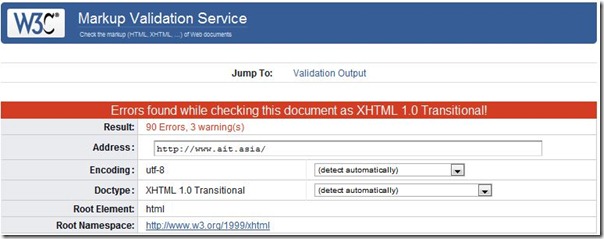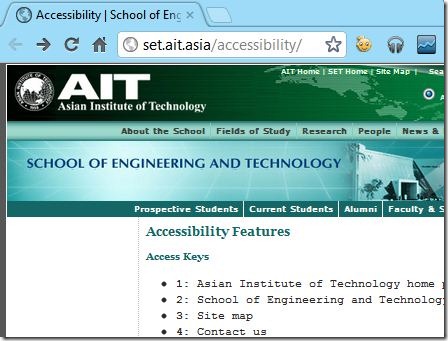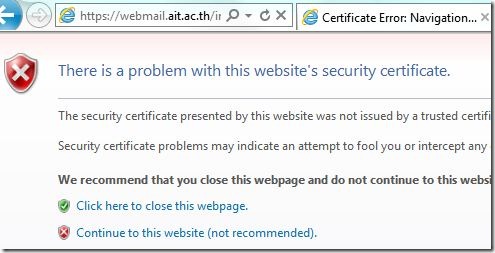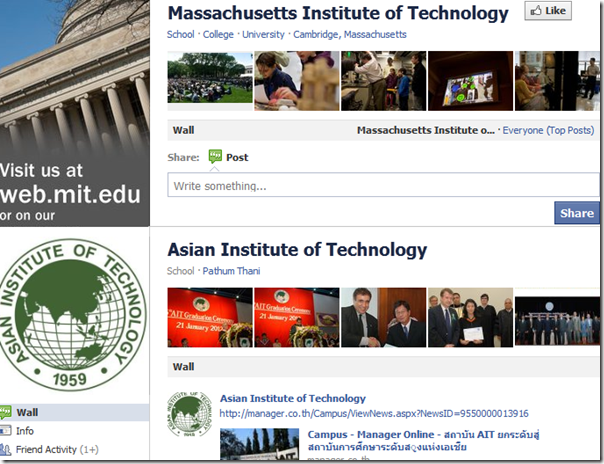Since long AIT’s main website has been one of the best to demonstrate worst examples in design and related web services classes in AIT itself, seems like even professor’s couldn’t suggest the people behind the website.I had compiled a list of pitfalls and bad design points of the AIT website, namely ait.asia, back in my first semester; and after attending my forums (later CLIQ’s ones) I thought everything gonna be alright with time. But it remained the same after all. So, I’m not only going to figure out problems, but also related solutions from my technicalities (and maybe sometimes my suggestions are limited to my knowledge), hope it will be some betterment.
Website update, btw what’s that? This article doesn’t talk about why AIT’s website is not updated at large(sorry about that.)
1. Home page and issue of ‘www’
What is the main website of AIT? ait.ac.th or ait.asia ? And again, do you need to include a ‘www’ or not? Well, results are vastly different. The simple screenshot here describes it a bit.
Previously, entering ‘www’ (which is nothing but a mere sub-domain and websites work even without www aka naked domain) was compulsory in AIT’s site but now it is flexible. (Read: www. is deprecated, also read: www. is not deprecated)
They should manage one URL (either ac.th or .asia – maybe the later one since AIT should go int’l) as a primarily URL while redirecting another into it, and encourage links without ‘www’ (no any technical rules here) – http://ait.asia/ or http://www.ait.asia/ which looks cool?
Another thing is; they have not integrated AIT’s website with opengraph meta and search engine submission, plus they are blocking all user-agent robots aka web spiders including the internet archive (see IA for ait.ac.th) robots which is used to create historic instances of websites (I don’t know in which way it is better to block those spiders and not to get indexed ranks, it is strange.)
The Google page rank for the site is 5/10. However, Alexa Rank is strange: AIT.asia is 989k whereas AIT.ac.th is143k ranked globally, so it is again strange to learn the entire Internet is still considering AIT.asia and AIT.ac.th as 2 different websites with different ranks technically. I remember AIT.ac.th was around 60k rank roughly around November 2010; and now maybe the flood is responsible for decreased rank since AIT had a temporary site then.
2. Non-device adaptive pages
Laptops (desktops ?) are no longer only the devices to check in websites, right? We got tablet of our choice, smart phones and other portable gadgets capable of full web browsing; but still we want the pages to adapt to our gadget’s display resolution. Enter ait.asia on your iPhone, you will see the regular site as like in your computer. Whenever people visit websites or web services from their handhelds, they want the optimized version.
It is time for AIT.asia to go mobile, and device specific rendering. Start from tableless design of the site (dig into AIT.asia & don’t get surprise with tables in the html).
3. SEO, SEF & Frames inside pages
Even tho’ all modern browsers support frames, it is a big no when it comes to browsing from a mobile device, and sadly as said in #2 AIT’s website is not mobilic. And instead of embedding pages inside pages, they are enabling frames inside frames – a bad and obsolete web design techniques.
For years now, I’ve been consulting many organizations on Search Engine Optimization (SEO), Search Engine and Human Friendly URLs (SEF), Social Media Optimization (SMO) and similar optimization for their websites and services. These all generate a good blend of web traffic, usability and sense of understanding. AIT is doing well on SEF thing but none on SEO and SMO. All the permalinks look pretty and even memorable for human eyes; but SEO and SMO goes badly implemented, not implemented at all. This things is not explainable on this post.
Update: Google webmaster tool site-verification has been implemented, one step ahead, but what about other search engines.
4. Basic Validity and Web Standards
The W3C markup validator result showed “invalid html and css” (see here the live result) for many pages including the home page, this means page rendering will not be performed well in various browsers and resolution including OS of the user. The universal standards of open web platform are governed by W3C and available on their page, this is adopted by almost all webmasters globally.
5. Accessibility
This one is similar to #4 and many websites tend to ignore it, but organizations involving users irrespective of abilities ensure that their web services can be equally used by all people – abled or differently abled. Great are the websites that can be browsed by those having visually impaired, problem with limbs, color contracts and others.
While SET’s website claims that the site is accessible for disabled; but not all pages in that subdomain are friendly as well. It is very important that AIT maintain it’s website (obviously not all web services can be done) validated for accessibility for the institute enrolling and not-biasing students (let alone external site visitors) with disabilities. Even tho’ AIT says in this accessibility-info page, that the website has certain access-keys, and is WCAG valid (which was when Plone – the CMS on which the site is based – was still not exploited), the results are awry; try yourself.
6. Non-uniformity in subdomains
AIT should opt standard CMS and web development platforms from a thorough research; which should include the one with flexible integration with #13 as well.
While AIT’s main site uses plone (a CMS that’s not much popular in comparison with others), different departments use their own taste of the web softwares from Joomla to basic pages developed in Frontpage to WordPress, and some even completely in Flash, some in Google Pages, some in WordPress (both self-hosted and free ones).
I found at least two different tracking codes (Google Analytics) in AIT’s different sub-domain pages. And according to GA, it is best to implement the same code with multiple sub-domains and domain feature everywhere, so that entire universe of the users (AIT’s overall web traffic) could be tracked, analyzed and acted upon. (Read: Tracking Multiple Sub-Domains and Domains from GA)
Usually every departments have a sub-domain where their choice of web software is installed based on department’s own decision (?), but how can they decide it? Do every departments in AIT has a person dedicated to it or should AIT have a separate IT department to assist departments on this regard.
7. Lagging in Email Services
AIT uses Horde Email Platform served from the server in AIT. The email services is one of the most sluggish we have ever noticed. This gets worst when our AIT email is POPed or IMAPed from popular free providers like Gmail/Yahoo/Hotmail or even from email clients like MS Outlook/Thunderbird and so on. While AIT encourages users to use the webmail (direct url) version to check emails in order to cut off the stress on the mail server while retrieving and processing emails from third party services on behalf of AIT’s mail servers; they can still cloud deploy the email service.
Why not have mail server hosted at different places/IP addresses and encourage the distributed usages?
Another point is AIT IT Team should go handy with Gmail/Hotmail/Yahoo and other email services to enlist that AIT’s mail server is authentic one and never report spam for any mails generated from our servers (maybe AIT should be strict on this). AIT can use DKIM (DomainKeys Identified Mail) protocol for authenticating outgoing emails on the servers, allowing users to send mail through an external SMTP will reduce stress in AIT’s mail server. People should get hands on it.
8. Time to Cloud
It is very time AIT should go cloud, maybe gradually upgrading services would be better. At least cloud for email and document server. This also help #13 below. AIT might have learnt from recent Thai flood which caused AIT to disconnect (lost?) servers and workstations for many weeks; this kind of server and service disconnection for a University like AIT is a big lost, at least for researchers and students working on this area.
Had AIT gone to (private) cloud solution, there might have been no interruption in any of the AIT’s web services including email services last October-December.
The major benefit of going cloud for AIT would be proper management of its email server, and best for document management system (EDM), where we can totally avoid installing office packages in every machine in the office. Since AIT has a good infrastructure (flood?) with a large bandwidth in internetworking, they could save millions on the softwares and hence increase productivity. (Myself working on feasibility of Google Apps /MS Office 365 for AIT in spite of AIT’s interest.)
NOTE: Going cloud for AIT has been in few talks by now. But it looks unheard.
9. Use SSO when collecting responses
Okay, time and again AIT (SU as well) sends students forms and other notices for collecting responses. While others are just documents that should be accessible only to AIT’s members. On such cases, AIT should implement a single sign-in options – avoiding users to login (time and again) with credentials (different ones, usually).
They require student to fill name, id, fos and other general information time and again; which is totally a waste of time (why? because the sender doesn’t know how to implement the system to avoid it.)
SSO problem and integration of various resources should come under AIT’s main technical priorities now. They might eliminate this problem if they go cloud with Google Apps (or others). I am elaborating the problem stated inside the quotes above from the snapshot above, where user access is auto system determined so that only the authentic users are permitted to modify/access the docs. In the example, it shows how productivity can be achieved in organization when they use Google Docs (form) for collaboration.
10. Use of SSL
Many of use who use SIS and Webmail might have already notice that AIT even doesn’t have a permanent solution to secured pages (SSL certificate installation in the server) and we must force browser to accept the connection. Atleast in login pages, AIT should implement secured logins. Anyone now can sniff into non-SSL login pages (over wireless), and what’s keeping AIT away from purchasing a SSL certificate just for 70$ a year (this is not about depending on any company and not about cost-saving as ITServe explains – see the quote below.)
SSL Certificates ensure that the site user is visiting is trusted! The solution given by the ITSU is not a permanent solution at all, if so they should timely suggest all AIT users to install the certificate, however this one is for mail server only, not for AIT site-wide login.
To improve the security of the e-mail service at AIT, also as a cost-saving measure and to avoid depending on a company, ITServ has setup a SSL Certificate Authority that is now used to generate the certificates required for encrypted communications with the mail servers.
11. University people pages
Almost all popular and big universities, and academic institutes have people pages – usually few static pages as a formal and official university web page of professors, instructors and students, and sometimes even staffs. Previous year there were discussions regarding the professor’s university page in AIT (as corresponded in CSIM mails) and this got lost with time.
AIT has already allocated some web space for students so that they can set up their websites like I have at http://stweb.ait.asia/~st111478 (this is not functional now after the flood, and Netlink deletes this web folder every few months which is total crap) This means they are not motivating students to have their web present, isn’t it? Unification might be sought.
12. Network exams online
This is ideal to replace some possible 3 hours traditional exams making them online. In one of the exams (yes, same 3-hours written exam in a practical subject) last semester, the instructor sent correction to questions by emailing to the department secy; and while we were giving exams, we got to correct the figures. How justice was it?
Whenever possible, AIT should encourage instructors to take exams online (this should be the trend now, lets discuss this with #10 myths of AIT.)
13. eLearning Platform
A must for AIT like institute – eLearning software from Moodle to AIT IntERLab’s own vClass – we got lot of options. AIT can also adapt model of clouds from #8 above. It is true that various departments and even instructors are deploying several eLearning softwares on their own. But if AIT makes it unified then centralized management could be far better than the current one.
Once everything on eLearning platform goes unified, students can access materials online; and even give tests and exams despite of different fields. However, the adoption of a proper eLearning platform for a university like ours require a lot of discussions (CLIQ held once, and … deductions are not yet out) before deploying.
14. Social Media Engagement (SMI)
Well, AIT got a Twitter account which is directly linked from Facebook, expect no response if you mentioned @AITasia, looks like the twitter account is just a formality. They should not forget the power of Twitter microblogging and user engagement (lot of examples of university twitter handles are there).
Maybe there is a debate, should universities block their Facebook wall?
Well, the entire AIT is in Facebook, the fb page fb.me/AITAsia is actively updated but the wall has been blocked for public recently (so where would people ask their queries and share interesting things with the AIT community?) I quick logged into fb page of UCLA, Rice, Princeton, Oxford, Stanford, IIT, MIT and found wall open and interactive for users. Why is AIT being so pessimist about this?
![]() AIT in YouTube channel and LinkedIn is also active because of direct user interaction, which is a good presence of social media in universities. Have you ever share articles from AIT’s website? The social media icon as illustrated at the right side are wrongly configured (configured in a personal account not in AIT’s one), and they have been there since many years.
AIT in YouTube channel and LinkedIn is also active because of direct user interaction, which is a good presence of social media in universities. Have you ever share articles from AIT’s website? The social media icon as illustrated at the right side are wrongly configured (configured in a personal account not in AIT’s one), and they have been there since many years.
Why so many Facebook pages of AIT?
Well, no surprise that departments/FoS and even student groups can open their own customized social media presence (say Facebook page here). But why is Student Union (SU) opening so many fb pages. (One friend who is voluntarily active with SU: I don’t know why SU’s every committee member wants a facebook page rather than maintaining the SU website), sadly SU’s website is on wordpress.com which is a free blogging platform and not updated since last 2 semesters http://suait.wordpress.com/ (big no no).
15. AIT’ Internet marketing (Ads)
I was surprised to see ads (Google ads) of AIT’s SET in my own website earlier. That’s good. AIT is going into digital/internet marketing. They should go viral on this with active participation in Social media as well.
Good Webpages from Departments
Okay, enough said about the main website, there is no good talking about that. However, many websites from departments and Field of Studies are mind blowing. You can’t believe they are AIT’s pages.
- Greenbook.ait.ac.th (sadly, greenbook.ait.asia doesn’t open) – Greenbook -is the site for searching AIT’s list of experts filtered by expertise, language, and geographical expertise.
- Serd.ait.ac.th – SERD’s website, everything is managed and text-based unlike AIT’s main site which is image based
- Pmbf.ait.ac.th – AIT’s site of Professional Master’s Program in Banking and Finance, they got Moodle site as Virtual learning environment (VLE) as well
- Extension.ait.ac.th – They are always updated, even during the flood period; and use many professional web standards in the Drupal based website.
Share the love of AIT: AIT’s Different!







Points to be noted.
All points are justifiable. If someone visit AIT website, they will get lost. They should promote ait.asia, use cloud based reliable web services, go mobile.
Since NetLink looks after the maintenance of the website, they should be notified.
Atleast AIT has come up with 1 good reform in their email system; this has to be done years before.
Now AIT will use only @ait.asia email address; hope someday they will end up completely or re-direct permanently @ait.ac.th addresses and URIs. See this image.
Co-incidence or lesson learnt: AIT just circulated for emphasizing .ait.asia email addresses. When will they go beyond email to domain/site thing, plus cloud based email? AIT really sux in technology; they are using centuries old tech…
Pingback: Fate of a popular virtual library - library.nu
Pingback: Installing WordPress blog or any CMS on Windows Azure cloud, how to